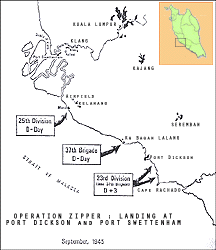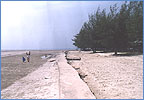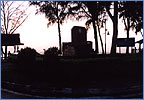|
 Operation Zipper Operation Zipper
Operation Zipper
is to
be
launched from Ceylon (Sri Lanka) and various parts of India, was planned for
September 1945. It was too far
advanced to be cancelled and went ahead as an exercise but without naval or
aerial bombardments. It
entailed landings on the West Coast of the Malay Peninsula north of Port
Dickson and south of Port Swettenham (now Klang).
General Robertís XXX1V Indian Corps (5th, 23rd,
25th and 26th Indian Divisions, 3rd
Commando Brigade and one Parachute Brigade of the British 6th
Airborne Division, comprised a force of more than 100,000 men.
These
men were expect to get some warm reception from the Japanese Army who were
stationed up in Kuala Lumpur. At that time of the Zipper landing, there were
6,000 Japanese troops stationed in Kuala Lumpur but they did not give any
threat to the landing forces.
Three
different landing zones were selected. 25th Division will landed on Morib
Beach, 37th Brigade will get to the Bagan Lalang Beach, 10 miles south Morib
and 23rd Division will scattered on Port Dickson beach.
The
Zipper convoy had sailed from Bombay, Madras, Calcutta and Rangoon, and were
converging on the Malayan coast at Port Swettenham. Escorted by HMS Nelson,
flying the flag of Admiral Walker, and Richelieu, the cruisers Nigeria,
Cleopatra and Ceylon, the 21st Aircraft Carrier Squadron of Royalist (
Commodore Oliver ) and the escort carriers Hunters, Stalkers, Archer,
Khedive, Emperor and Pursuer and fifteen destroyers, the first D-Day assault
convoys arrived off their beaches at first light on 9 September.

Operation
Zipper : Map of the Operation
Port
Swettenham and Klang were occupied on the first day, Kelanang airfield was
handed over by the Japanese. Port Dickson was occupied the next day. On 12
September a new beach was opened farther south at Cape Rachado, where the
23rd Division landed without any of the difficulties met at Morib.
By
the time the beaches were closed, Morib on 25th, and Cape Rachado on 28th
September, 63,838 troops, 7,337 vehicles and 25, 671 tons of stores had been
landed over them.
British
troops entered Kuala Lumpur without resistance on 13 September.
However,
post war assessment showed that the Japanese had only 130,000 troops in the
whole Malaya, and the Zipper with a quarter of a million men and full fire
support from air and sea would certainly have succeded.
On the beaches
right now, nothing were left except for the memorial stones erected by the
landing forces to commemorate their historic landing 60
years ago. On the stones erected by 46th Indian Beach Group in 9th September
1945.
Not
so many people knew about this significant landing occurred on this beaches.
Perhaps this beaches served them as the most popular picnic and swimming
spot for weekenders.
 |
|
 |
|
Panoramic
view at Bagan Lalang Beach |
|
New
seawall construction to prevent sea erosion |
|
|
|
 |
|
 |
| Memorial
Stone at Morib Beach |
|
The stone
was laid on the popular spot at Morib Beach |
|